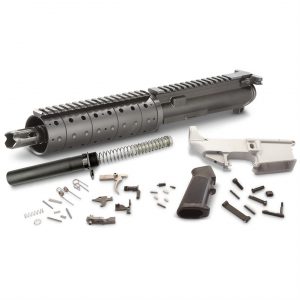
The Complete Form 1 Guide
The instructions below are still valid for the post-41F paper process.
However, with the return of eForms for Form 1 submissions, you should take advantage of the drastically shorter approval times by following my Form 1 Guide for eForms here.
It’s time to submit a new Form 1. But 41F is fully in effect. But fear not. This Form 1 guide will walk you through every step of the new process. Despite the complexity, I will try and make it as easy as possible.
Getting the Form 1
This is very important! In the past, even when the ATF released a new version of the Form 1 or Form 4, they would generally still accept applications using the older version of the form. That is no longer the case! Any application not on the new form will be rejected!
The new blank Form 1 is available on the ATF website. The form itself is well designed with fillable fields which auto-transfer the data to two additional copies (based upon testing, it seems that you must use Adobe Acrobat Reader for these features to work reliably). I will instruct you where to send each copy later in this Form 1 guide.
You should download the form and then complete it according to the following instructions:
Form 1 Guide – Page 1
- In Box 1 you should check option a.
- In Box 2 you should check the box for TRUST.
- Box 3a should be left blank.
- Box 3b should contain the name of your trust (exactly as it appears on the header of the trust document) and the mailing address for the location where the item will initially be stored.
- Box 3c should be blank unless the mailing address in Box 3b is a PO Box. In that case, the physical address should be entered here.
- Box 3d should contain the name of the county in which the physical address from 3b/3c is located. Note: Virginia is one of the few states where there are independent cities that are not part of the surrounding counties. If you live in an independent city (like Alexandria for example) then put your city in 3d (e.g. “Alexandria City”).
- Box 3e should contain the best number at which to reach the Trustee or Settlor submitting the application.
- Box 3f should contain your email address.
- Box 4a should contain the manufacturer’s name and the location in which it was manufactured. It is critical that you enter them exactly as they are engraved on the lower! However, if you have a foreign manufactured firearm, you must also be careful to identify the name and location of the original manufacturer and not the importer (which might also be engraved on the lower). If you are manufacturing your own suppressor, or your own SBR based on an un-serialized 80% lower, then your trust is the manufacturer and you should put the trust name, city, and state here.
- Box 4b should contain either Silencer, Machinegun, Short-Barreled Rifle, Short-Barreled Shotgun, AOW, or Destructive Device. There have been unconfirmed reports of the ATF rejecting applications for putting ‘Suppressor’ instead of ‘Silencer’ in this field.
- Box 4c should contain the initial caliber of the item being built. Do not put ‘Multi’ as the caliber even if that is what is engraved on the lower. While you may have multiple uppers for your registered lower, you need to declare a specific primary configuration in this application and you need to retain the ability to return to this configuration. This value should contain the number and the unit of measure such as .30 Cal, 9mm, or 12 Gauge.
- Box 4d should contain the model number of the item. Once again, it is critical that you enter them exactly as they are engraved on the lower! If you are manufacturing your own suppressor, or your own SBR based on an 80% lower, then you will need to assign a model name.
- Box 4e should contain the length of the barrel in inches. If you are building a suppressor then you should put ‘N/A’ in this field.
- Box 4f should contain the estimated overall length of the firearm in inches. I say estimated because you cannot assemble the firearm in advance to do precise measurements. Having said that, the overall length should be estimated based upon an extended stock.
- Box 4g should contain the serial number of the item. At the risk of repeating myself, it is critical that you enter the serial number exactly as it is engraved on the lower including any alpha-numeric characters! If you are manufacturing your own suppressor, or your own SBR based on an 80% lower, then you will need to assign a serial number. Many people simply start with 001 and proceed in series as they build additional items.
- Box 4h should contain the information that you are going to engrave on the NFA item (Trust Name, City, State). In the past, I advised that this box be left blank but recently the ATF has been indicating that they want this completed.
- Box 4i should be answered ‘All lawful purposes’.
- Box 4j should be left blank unless you are actually building a Destructive Device. I frequently get questions about this box from clients who are confused by the fact that there is a box for ‘Firearm’. You do NOT need to check this box unless you are building a Destructive device that happens to be a firearm (Any weapon by whatever name known which will, or which may be readily converted to, expel a projectile by the action of an explosive or other propellant, the barrel or barrels of which have a bore of more than one-half inch in diameter (.50 inches or 12.7 mm), except a shotgun or shotgun shell which the Secretary finds is generally recognized as particularly suitable for sporting purposes)
- Box 4k should be answered ‘No’ unless you are one of the extremely rare applicants who is actually reactivating a firearm.
- Boxes 5 and 6 should both be left blank.
- You should sign in Box 7. (More about this in the signing section below)
- In Box 8, you should put your full legal name and follow it with ‘- SETTLOR AND TRUSTEE’ as the title.
- Box 9 should contain the date the application is completed.
Form 1 Guide – Page 2
- Box 10 should contain the information about the applicant’s CLEO.
- Boxes 11 through 17 should be left blank. For trust applicants, these background questions and photos will be part of a separate form for each ‘responsible person’ (Form 23) for which I will provide instructions further down in the Form 1 guide.
- Sign and date at the bottom of Page 2. (More about this in the signing section below)
Form 1 Guide – Page 3
- Box 18 should contain the number of responsible persons on the trust. I have a detailed article here laying out which persons on your trust are considered ‘responsible persons’ but the short answer is that you are a responsible person and so are those people listed on Schedule B of your trust. If you want to remove joint trustees from your Schedule B before submitting your application I have a guide to doing so here.
- Box 19 should contain your full legal name and the full legal names of all those on Schedule B of your trust.
- Box 20 should contain your method of payment and, if you are paying with a credit card, the information about the credit card and the amount being paid. You only need to sign in Box 20 if you are paying with a credit card. (More about this in the signing section below)
A Completed Sample of Form 1
The following sample form illustrates what a completed Form 1 should look like.
Printing The Completed Form 1
Once you have completed the Form 1, you will need to print it. Per the instructions on the latest version of the form, it is no long required that you print the completed form double-sided!
It will print 3 copies. I will cover where to send each of these copies later in this guide.
Signing the Completed Form 1
Each copy of the completed Form 1 should be signed in the following places:
- On Page 1 Box 7 sign your name and add “as trustee” at the end.
- On the bottom of Page 2 sign the Makers Certification with your name and add “as trustee” at the end.
- Only sign on Page 3 Box 20 if you are paying with a credit card.
Important: The ATF requires all signatures to be in either blue or black ink.
Turning to the Form 23
I have a comprehensive guide to the Form 23 here.
Notifying Your CLEO
The Settlor of the trust will need to mail his or her CLEO (from the Form 23) the CLEO copy of the Form 1 and the CLEO copy of their Form 23.
All other responsible persons will only need to mail his or her CLEO (from their Form 23) the CLEO copy of their Form 23.
Important Note: The CLEO copy of the Form 23 does not have a photo affixed. You should also not send fingerprint cards to the CLEO.
Fingerprint Cards
Each Form 23 to be sent to the ATF will need to be accompanied by fingerprints of the responsible person taken on 2 FBI (FD-258) fingerprint cards. As I noted here, many NFA dealers are planning to offer in-store fingerprinting so you should check with your local gun store. Failing that, you should be able to get fingerprinted at your local law enforcement agency. No matter who does the fingerprinting, you should make sure that they use the correct FD-258 cards.
Mailing the Completed Form 1 Packet to the ATF
Now we need to prepare the packet to mail to the ATF. Note that If you are building more than one NFA item, you will need a separate packet for each item.
This packet should include:
- The first 2 copies of the completed Form 1 with original signatures in blue or black ink on both copies. (These are marked ATF Copy and ATF Copy 2 on the bottom of the forms)
- The ATF Copy of the Form 23 for each responsible person of the trust with photos affixed and fingerprint cards included. (DO NOT STAPLE)
- A single copy of your notarized trust instrument (including all schedules)
- Payment for the amount of the tax ($200) payable to BATFE (unless you entered credit card info on the Form 1)
The entire packet should be mailed to:
National Firearms Act Division
Bureau of ATF
PO Box 5015
Portland, OR 97208-5015
If this guide leaves any questions unanswered, please feel free to contact me.





